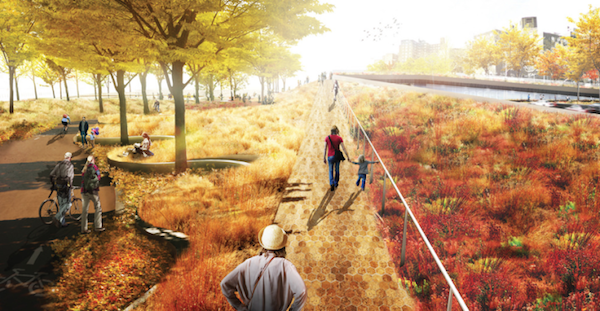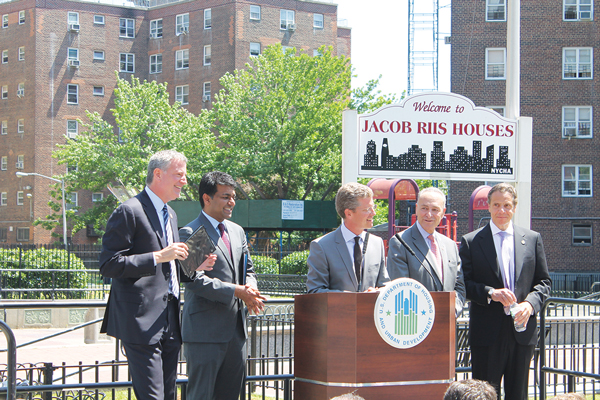
BY LINCOLN ANDERSON | In a united front, Mayor de Blasio was joined by Governor Cuomo, Senator Chuck Schumer and HUD Secretary Shaun Donovan at the Riis Houses on Monday to announce a massive allocation of federal funding to protect the East Village and Lower East Side from flooding in an age of dramatic climate change.
The scene Monday was beautiful, as a dazzling, hot sun shone down, as a crowd of Riis residents and press clustered near to hear the high-powered officials. It was a far cry from Oct. 29, 2012, when Superstorm Sandy slammed the city, swamping the East Side, with the waters rising waist-high on Avenue C.
The city’s overall plan to protect vulnerable neighborhoods in all five boroughs has a $3.7 billion price tag. On Monday, the officials announced that $335 million has been allocated for the “Big U” plan, specifically to allow construction of its Lower East Side and East Village sections, covering the stretch from Montgomery St. to E. 23rd St.
From a design team led by Danish firm BIG (Bjarke Ingels Group), the project was the grand-prize winner in the federal government’s Rebuild by Design contest.
Running parallel to East River Park, a “bridging berm” will be created on the F.D.R. Drive access road, which is currently used by joggers, bikers and other parkgoers. (A bike path is included in the design.)
“Both berms and bridges are wide and planted with a diverse selection of salt-tolerant trees, shrubs and perennials, providing a resilient urban habitat,” according to the “Big U” plan’s description. “The berm will offer accessible routes into the park, with many unprogrammed spots for resting, socializing and enjoying views of the park and river.”
Wharfs and swimming pools will also be added on the waterfront at E. 10th St. as part of the plan.
The berms, from 10- to 20-feet tall, reportedly could be completed in as soon as four years.

Addressing the crowd, de Blasio said, “We’re here in a part of Manhattan that was hit very hard by Sandy. For people who experienced those days — those weeks, in many cases — it was a time of incredible uncertainty, a lot of suffering, and it was a reminder of how people felt left without the help they needed, and facing an uncertain future, and facing the possibility it could happen again.
“Let’s put this in very human terms,” the mayor said, as he introduced Melba Torres, a resident of the nearby Wald Houses.
A lifelong Lower East Sider, Torres has cerebral palsy and uses a heavy, motorized wheelchair. When Sandy hit and the power went down, knocking out the elevators, Torres was stranded in her eighth-floor apartment for six days. Luckily, residents, along with Torres’s health aides, came to her assistance, including one aide who walked across the Brooklyn Bridge to reach her.
“That’s one story, one of thousands and thousands of stories, that it’s all of our job to make sure don’t happen again,” the mayor said. “The beauty of this project is, we are working to ensure that we fight against the floodwaters before they happen, with real protections for people on the East Side of Manhattan, tens of thousands of people, in public housing and private buildings alike.”
Four hundred thousand New York City residents live in the floodplain, more than in any major city in America, the mayor pointed out.
“We are who we are because we’re the ultimate coastal city,” the mayor said. “But it requires of us a new level of preparation.”
In his remarks, Donovan noted, “We’re standing here, near the Con Ed substation, which flooded [during Sandy] and caused the whole area to lose power.”
When he announced that the department of Housing and Urban Development will allocate the funding to allow the creation of the bridging berm, which will protect 150,000 residents, cheers rose from the crowd.
The planted project will be “a living breakwater,” he said.
The money will be well spent, Donovan assured, since every $1 put toward protection will save $4 in potential damages in future storms.
In that vein, Schumer said, “We know there will be other storms like Sandy that hit New York. But the goal is to make sure, when a storm hits, that the damage will be greatly reduced. … Sandy taught us that climate change is real and devastating.”
Cuomo said the federal money was part of $60 billion for New York State and New Jersey, which he called “a tremendous supplemental from HUD.”
He praised Schumer and Congressmembers Nydia Velazquez and Carolyn Maloney, noting, “They literally brought home the bacon.”
“Nothing is the same after Hurricane Sandy,” Cuomo said, “and nothing should be the same after Hurricane Sandy.”
Cuomo noted that in his three and a half years as governor, there have been nine major weather-related disasters, while there were just a handful during his father’s 12 years as governor.
“There is something that has changed with the weather pattern,” he said.
Speaking afterward, Gale Brewer, the Manhattan borough president, noted she was an early “Big U” supporter.
“I think it’s very exciting,” she said. “You’ll have an outside berm and an inside sponge — and then all the upland things that go with that.”
The “sponge,” including planted areas, will help soak up the floodwaters, she noted.
The overall “Big U” scheme, to be built in phases, would protect 10 miles of Manhattan shoreline, from W. 57th St., south to the Battery, and up to E. 42nd St.
Between the Manhattan Bridge and Montgomery St., deployable walls would be attached under the F.D.R. Drive, ready to be flipped down if there are flood events.
Councilmember Margaret Chin also gave a big thumbs to the “Big U.”
“It’s heartening to know that this project is no longer just an idea,” Chin said. “I’m looking forward to working with the BIG team and our neighborhood partners to move it forward.”
Elijah Parks, 19, a Riis Houses resident who was sitting on a bench afterward, said the berms are worth a shot.
“It could be aa-ight,” he said. “It could work. It should work. Because the last time, the water was like 6 feet high. I had to go to my grandmother’s house in Brooklyn. … I just hope it’s ready for the next storm.”

















